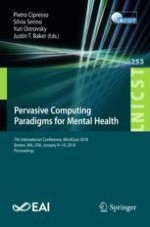2018 | Buch
Pervasive Computing Paradigms for Mental Health
7th International Conference, MindCare 2018, Boston, MA, USA, January 9–10, 2018, Proceedings
herausgegeben von: Dr. Pietro Cipresso, Dr. Silvia Serino, Yuri Ostrovsky, Justin T. Baker
Verlag: Springer International Publishing
Buchreihe : Lecture Notes of the Institute for Computer Sciences, Social Informatics and Telecommunications Engineering
